University Supply Chain Analysis: Value Chain Report
VerifiedAdded on 2022/10/18
|8
|1084
|44
Report
AI Summary
This report provides an in-depth analysis of the value chain within a supply chain context. It begins with an executive summary highlighting the report's aim to offer insights into industry value chain analysis, emphasizing how primary and secondary activities contribute value. The report defines the value chain as a business model encompassing all activities from product conception to distribution, including raw material procurement, manufacturing, and marketing. It explores the importance of value chain analysis in enhancing production efficiency and maximizing value at minimal cost, referencing Michael Porter's strategic management tool. The discussion section details both primary activities, such as inbound and outbound logistics, operations, sales and marketing, and services, and secondary activities, including procurement, human resource management, infrastructure, and technological development. The report concludes by emphasizing the competitive advantage that value chain analysis offers to companies. It also includes references to relevant academic sources.
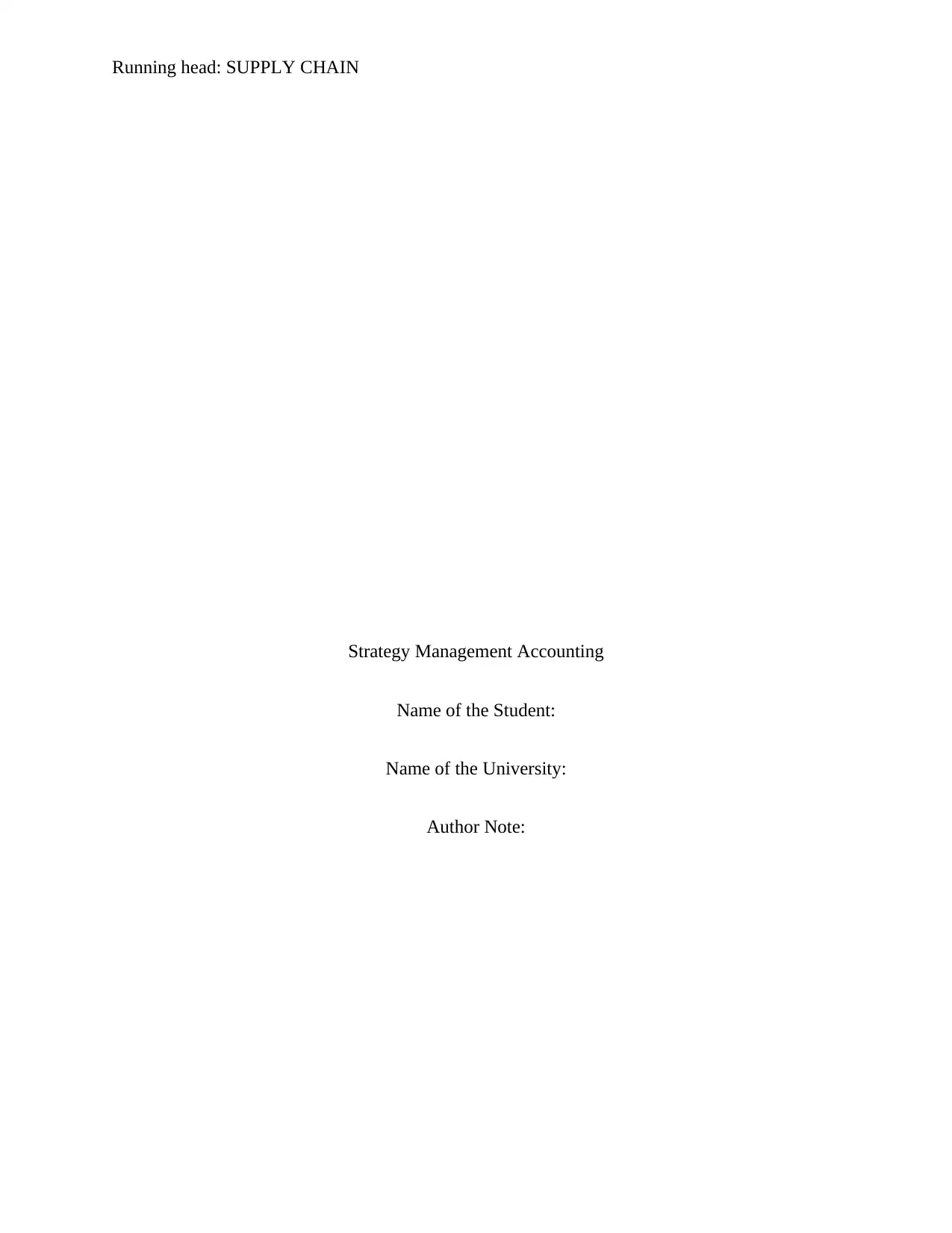
Running head: SUPPLY CHAIN
Strategy Management Accounting
Name of the Student:
Name of the University:
Author Note:
Strategy Management Accounting
Name of the Student:
Name of the University:
Author Note:
Paraphrase This Document
Need a fresh take? Get an instant paraphrase of this document with our AI Paraphraser
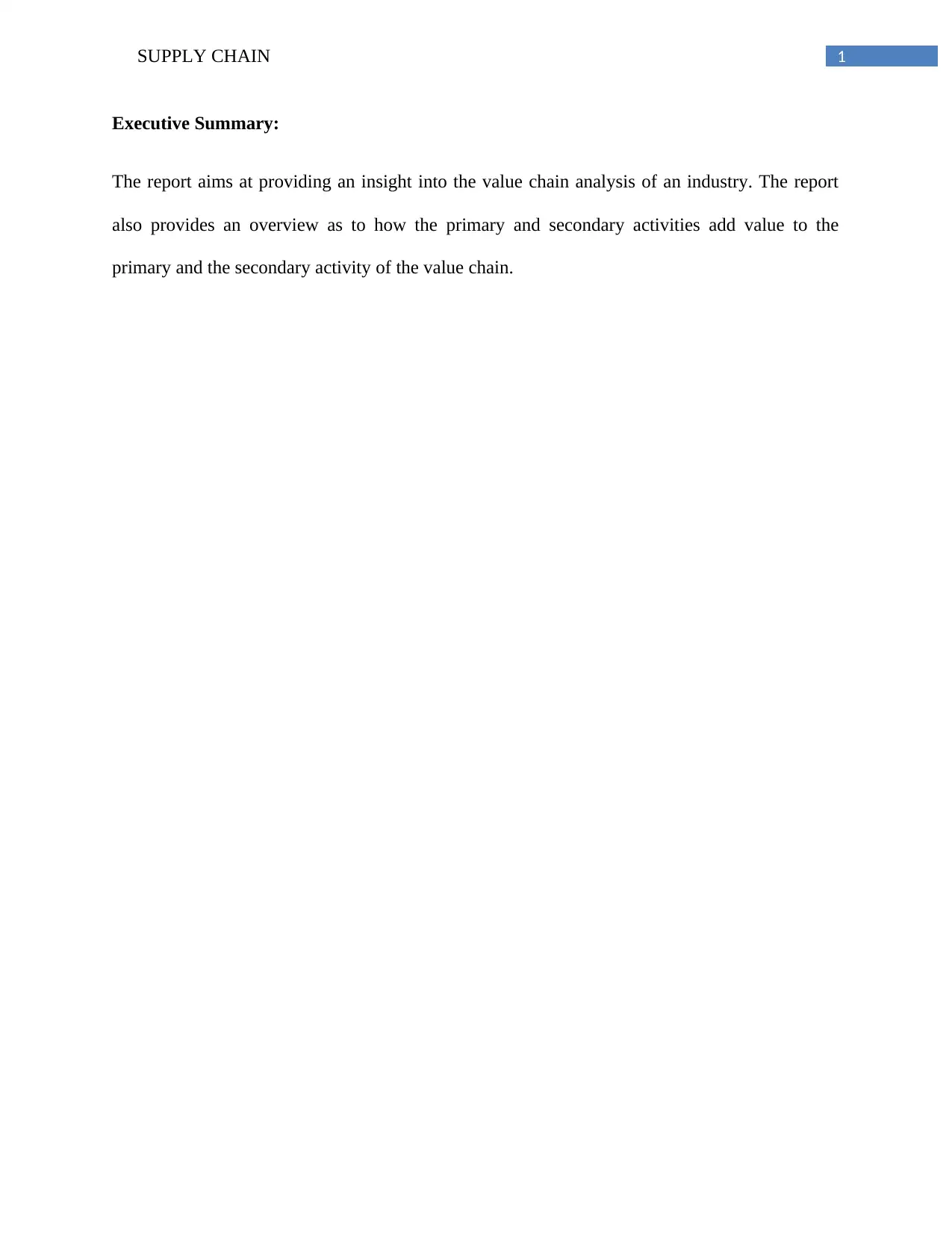
1SUPPLY CHAIN
Executive Summary:
The report aims at providing an insight into the value chain analysis of an industry. The report
also provides an overview as to how the primary and secondary activities add value to the
primary and the secondary activity of the value chain.
Executive Summary:
The report aims at providing an insight into the value chain analysis of an industry. The report
also provides an overview as to how the primary and secondary activities add value to the
primary and the secondary activity of the value chain.
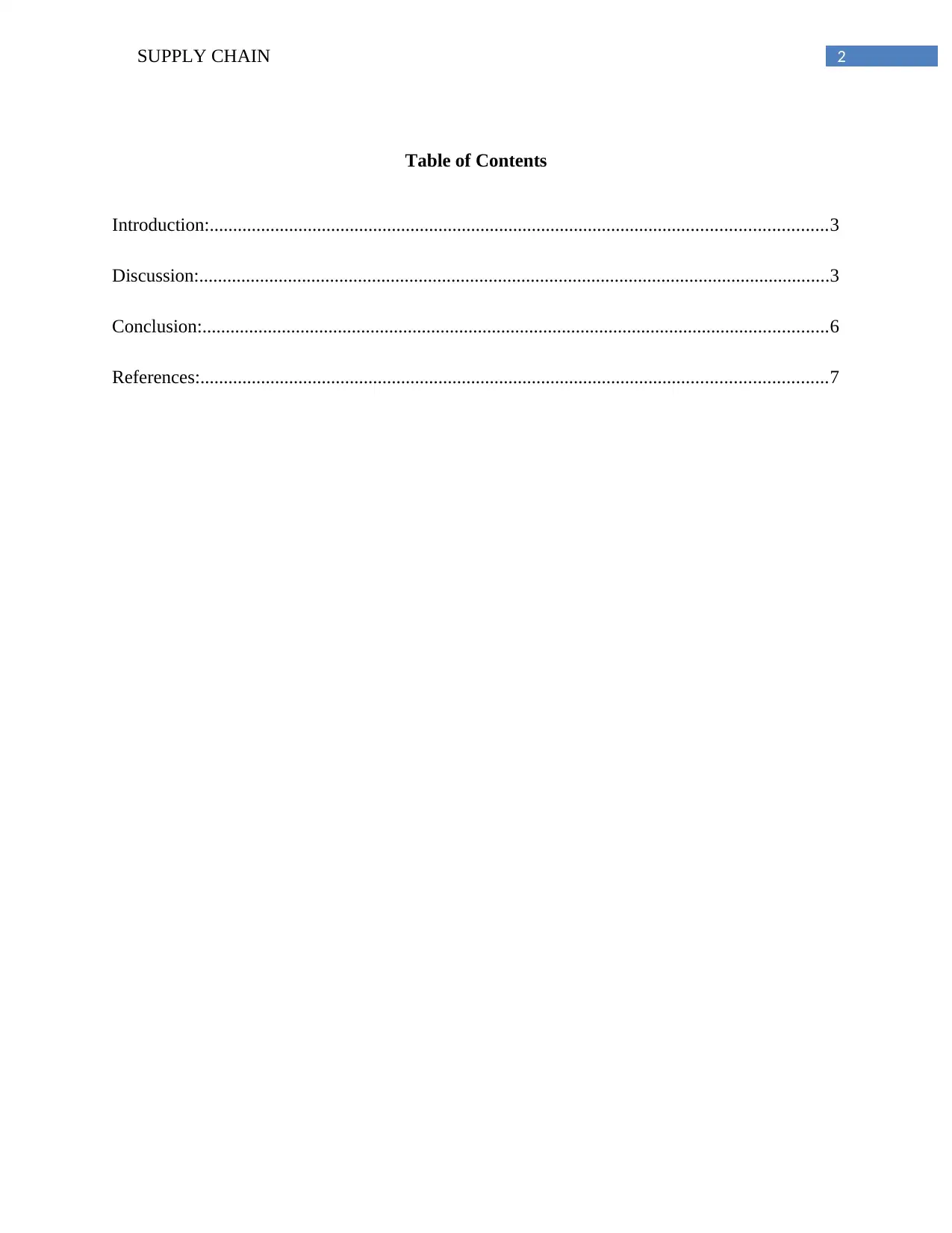
2SUPPLY CHAIN
Table of Contents
Introduction:....................................................................................................................................3
Discussion:.......................................................................................................................................3
Conclusion:......................................................................................................................................6
References:......................................................................................................................................7
Table of Contents
Introduction:....................................................................................................................................3
Discussion:.......................................................................................................................................3
Conclusion:......................................................................................................................................6
References:......................................................................................................................................7
⊘ This is a preview!⊘
Do you want full access?
Subscribe today to unlock all pages.

Trusted by 1+ million students worldwide
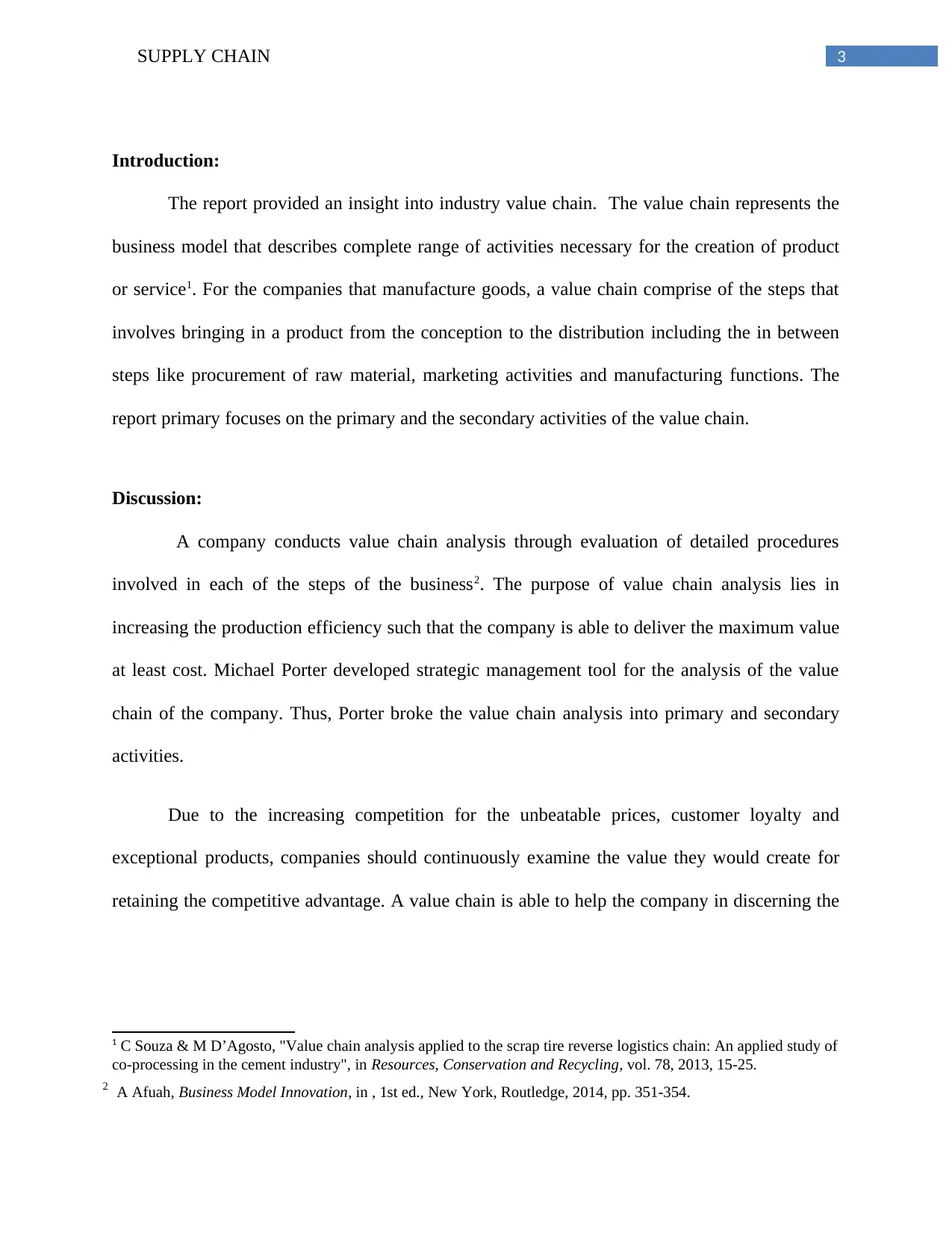
3SUPPLY CHAIN
Introduction:
The report provided an insight into industry value chain. The value chain represents the
business model that describes complete range of activities necessary for the creation of product
or service1. For the companies that manufacture goods, a value chain comprise of the steps that
involves bringing in a product from the conception to the distribution including the in between
steps like procurement of raw material, marketing activities and manufacturing functions. The
report primary focuses on the primary and the secondary activities of the value chain.
Discussion:
A company conducts value chain analysis through evaluation of detailed procedures
involved in each of the steps of the business2. The purpose of value chain analysis lies in
increasing the production efficiency such that the company is able to deliver the maximum value
at least cost. Michael Porter developed strategic management tool for the analysis of the value
chain of the company. Thus, Porter broke the value chain analysis into primary and secondary
activities.
Due to the increasing competition for the unbeatable prices, customer loyalty and
exceptional products, companies should continuously examine the value they would create for
retaining the competitive advantage. A value chain is able to help the company in discerning the
1 C Souza & M D’Agosto, "Value chain analysis applied to the scrap tire reverse logistics chain: An applied study of
co-processing in the cement industry", in Resources, Conservation and Recycling, vol. 78, 2013, 15-25.
2 A Afuah, Business Model Innovation, in , 1st ed., New York, Routledge, 2014, pp. 351-354.
Introduction:
The report provided an insight into industry value chain. The value chain represents the
business model that describes complete range of activities necessary for the creation of product
or service1. For the companies that manufacture goods, a value chain comprise of the steps that
involves bringing in a product from the conception to the distribution including the in between
steps like procurement of raw material, marketing activities and manufacturing functions. The
report primary focuses on the primary and the secondary activities of the value chain.
Discussion:
A company conducts value chain analysis through evaluation of detailed procedures
involved in each of the steps of the business2. The purpose of value chain analysis lies in
increasing the production efficiency such that the company is able to deliver the maximum value
at least cost. Michael Porter developed strategic management tool for the analysis of the value
chain of the company. Thus, Porter broke the value chain analysis into primary and secondary
activities.
Due to the increasing competition for the unbeatable prices, customer loyalty and
exceptional products, companies should continuously examine the value they would create for
retaining the competitive advantage. A value chain is able to help the company in discerning the
1 C Souza & M D’Agosto, "Value chain analysis applied to the scrap tire reverse logistics chain: An applied study of
co-processing in the cement industry", in Resources, Conservation and Recycling, vol. 78, 2013, 15-25.
2 A Afuah, Business Model Innovation, in , 1st ed., New York, Routledge, 2014, pp. 351-354.
Paraphrase This Document
Need a fresh take? Get an instant paraphrase of this document with our AI Paraphraser
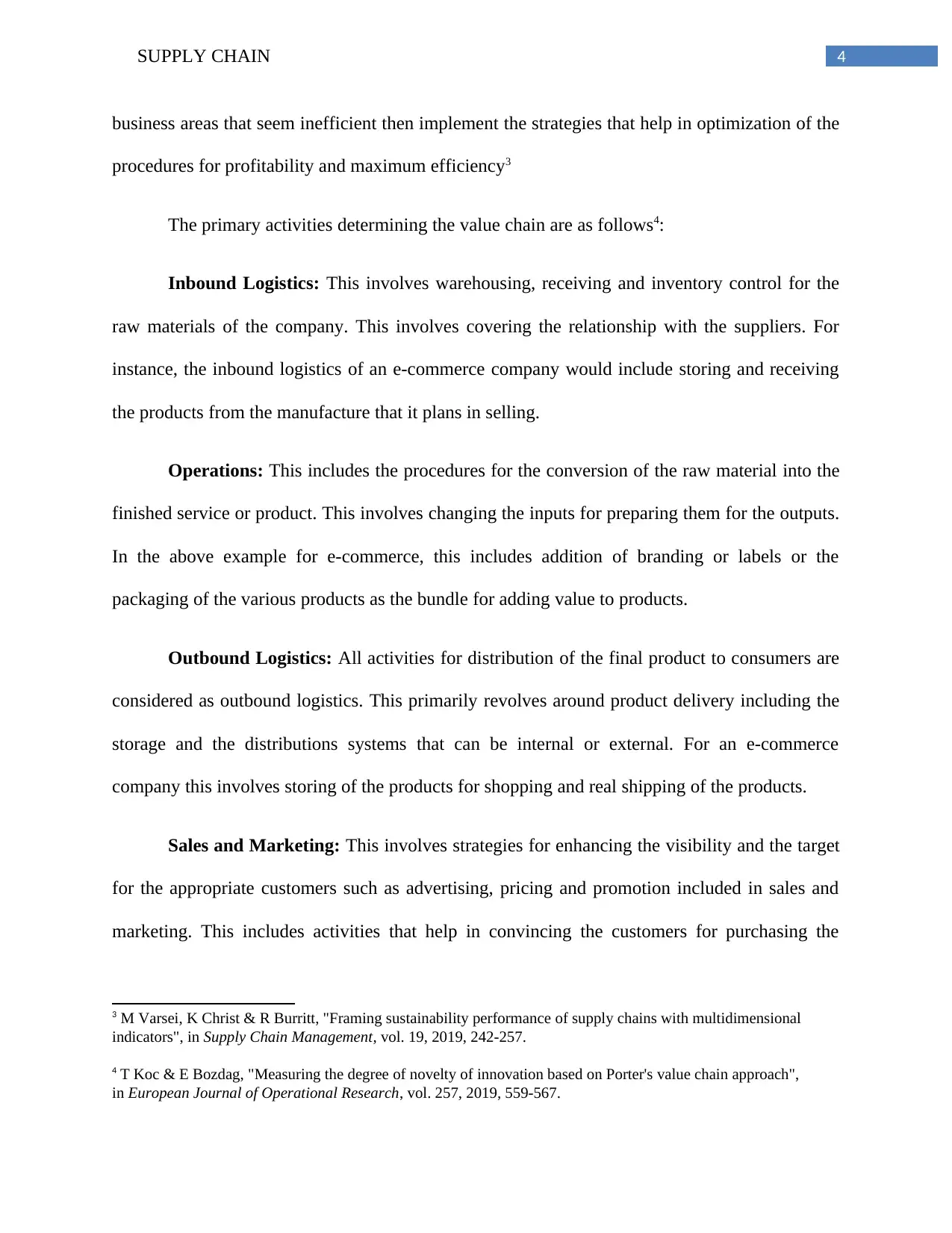
4SUPPLY CHAIN
business areas that seem inefficient then implement the strategies that help in optimization of the
procedures for profitability and maximum efficiency3
The primary activities determining the value chain are as follows4:
Inbound Logistics: This involves warehousing, receiving and inventory control for the
raw materials of the company. This involves covering the relationship with the suppliers. For
instance, the inbound logistics of an e-commerce company would include storing and receiving
the products from the manufacture that it plans in selling.
Operations: This includes the procedures for the conversion of the raw material into the
finished service or product. This involves changing the inputs for preparing them for the outputs.
In the above example for e-commerce, this includes addition of branding or labels or the
packaging of the various products as the bundle for adding value to products.
Outbound Logistics: All activities for distribution of the final product to consumers are
considered as outbound logistics. This primarily revolves around product delivery including the
storage and the distributions systems that can be internal or external. For an e-commerce
company this involves storing of the products for shopping and real shipping of the products.
Sales and Marketing: This involves strategies for enhancing the visibility and the target
for the appropriate customers such as advertising, pricing and promotion included in sales and
marketing. This includes activities that help in convincing the customers for purchasing the
3 M Varsei, K Christ & R Burritt, "Framing sustainability performance of supply chains with multidimensional
indicators", in Supply Chain Management, vol. 19, 2019, 242-257.
4 T Koc & E Bozdag, "Measuring the degree of novelty of innovation based on Porter's value chain approach",
in European Journal of Operational Research, vol. 257, 2019, 559-567.
business areas that seem inefficient then implement the strategies that help in optimization of the
procedures for profitability and maximum efficiency3
The primary activities determining the value chain are as follows4:
Inbound Logistics: This involves warehousing, receiving and inventory control for the
raw materials of the company. This involves covering the relationship with the suppliers. For
instance, the inbound logistics of an e-commerce company would include storing and receiving
the products from the manufacture that it plans in selling.
Operations: This includes the procedures for the conversion of the raw material into the
finished service or product. This involves changing the inputs for preparing them for the outputs.
In the above example for e-commerce, this includes addition of branding or labels or the
packaging of the various products as the bundle for adding value to products.
Outbound Logistics: All activities for distribution of the final product to consumers are
considered as outbound logistics. This primarily revolves around product delivery including the
storage and the distributions systems that can be internal or external. For an e-commerce
company this involves storing of the products for shopping and real shipping of the products.
Sales and Marketing: This involves strategies for enhancing the visibility and the target
for the appropriate customers such as advertising, pricing and promotion included in sales and
marketing. This includes activities that help in convincing the customers for purchasing the
3 M Varsei, K Christ & R Burritt, "Framing sustainability performance of supply chains with multidimensional
indicators", in Supply Chain Management, vol. 19, 2019, 242-257.
4 T Koc & E Bozdag, "Measuring the degree of novelty of innovation based on Porter's value chain approach",
in European Journal of Operational Research, vol. 257, 2019, 559-567.
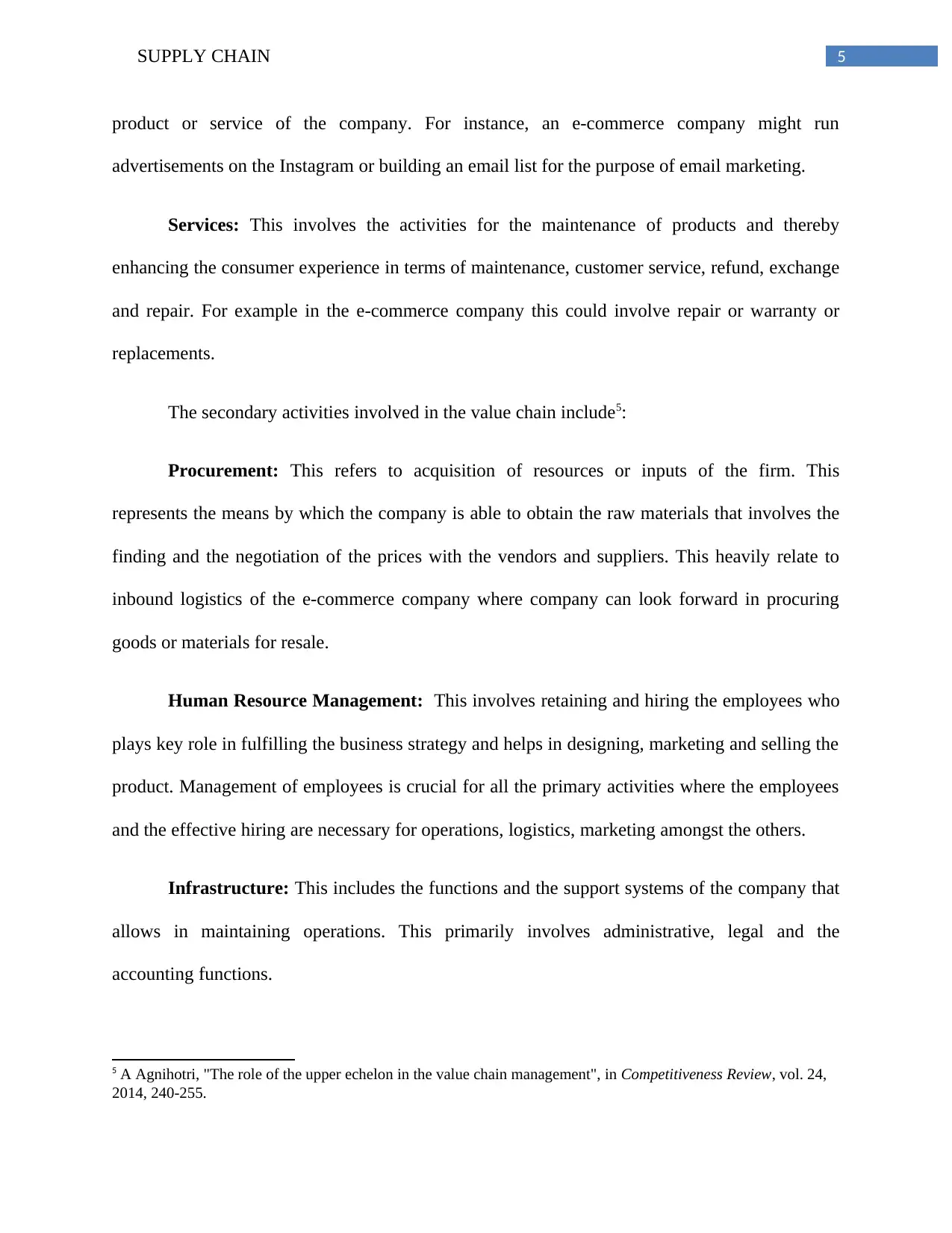
5SUPPLY CHAIN
product or service of the company. For instance, an e-commerce company might run
advertisements on the Instagram or building an email list for the purpose of email marketing.
Services: This involves the activities for the maintenance of products and thereby
enhancing the consumer experience in terms of maintenance, customer service, refund, exchange
and repair. For example in the e-commerce company this could involve repair or warranty or
replacements.
The secondary activities involved in the value chain include5:
Procurement: This refers to acquisition of resources or inputs of the firm. This
represents the means by which the company is able to obtain the raw materials that involves the
finding and the negotiation of the prices with the vendors and suppliers. This heavily relate to
inbound logistics of the e-commerce company where company can look forward in procuring
goods or materials for resale.
Human Resource Management: This involves retaining and hiring the employees who
plays key role in fulfilling the business strategy and helps in designing, marketing and selling the
product. Management of employees is crucial for all the primary activities where the employees
and the effective hiring are necessary for operations, logistics, marketing amongst the others.
Infrastructure: This includes the functions and the support systems of the company that
allows in maintaining operations. This primarily involves administrative, legal and the
accounting functions.
5 A Agnihotri, "The role of the upper echelon in the value chain management", in Competitiveness Review, vol. 24,
2014, 240-255.
product or service of the company. For instance, an e-commerce company might run
advertisements on the Instagram or building an email list for the purpose of email marketing.
Services: This involves the activities for the maintenance of products and thereby
enhancing the consumer experience in terms of maintenance, customer service, refund, exchange
and repair. For example in the e-commerce company this could involve repair or warranty or
replacements.
The secondary activities involved in the value chain include5:
Procurement: This refers to acquisition of resources or inputs of the firm. This
represents the means by which the company is able to obtain the raw materials that involves the
finding and the negotiation of the prices with the vendors and suppliers. This heavily relate to
inbound logistics of the e-commerce company where company can look forward in procuring
goods or materials for resale.
Human Resource Management: This involves retaining and hiring the employees who
plays key role in fulfilling the business strategy and helps in designing, marketing and selling the
product. Management of employees is crucial for all the primary activities where the employees
and the effective hiring are necessary for operations, logistics, marketing amongst the others.
Infrastructure: This includes the functions and the support systems of the company that
allows in maintaining operations. This primarily involves administrative, legal and the
accounting functions.
5 A Agnihotri, "The role of the upper echelon in the value chain management", in Competitiveness Review, vol. 24,
2014, 240-255.
⊘ This is a preview!⊘
Do you want full access?
Subscribe today to unlock all pages.

Trusted by 1+ million students worldwide
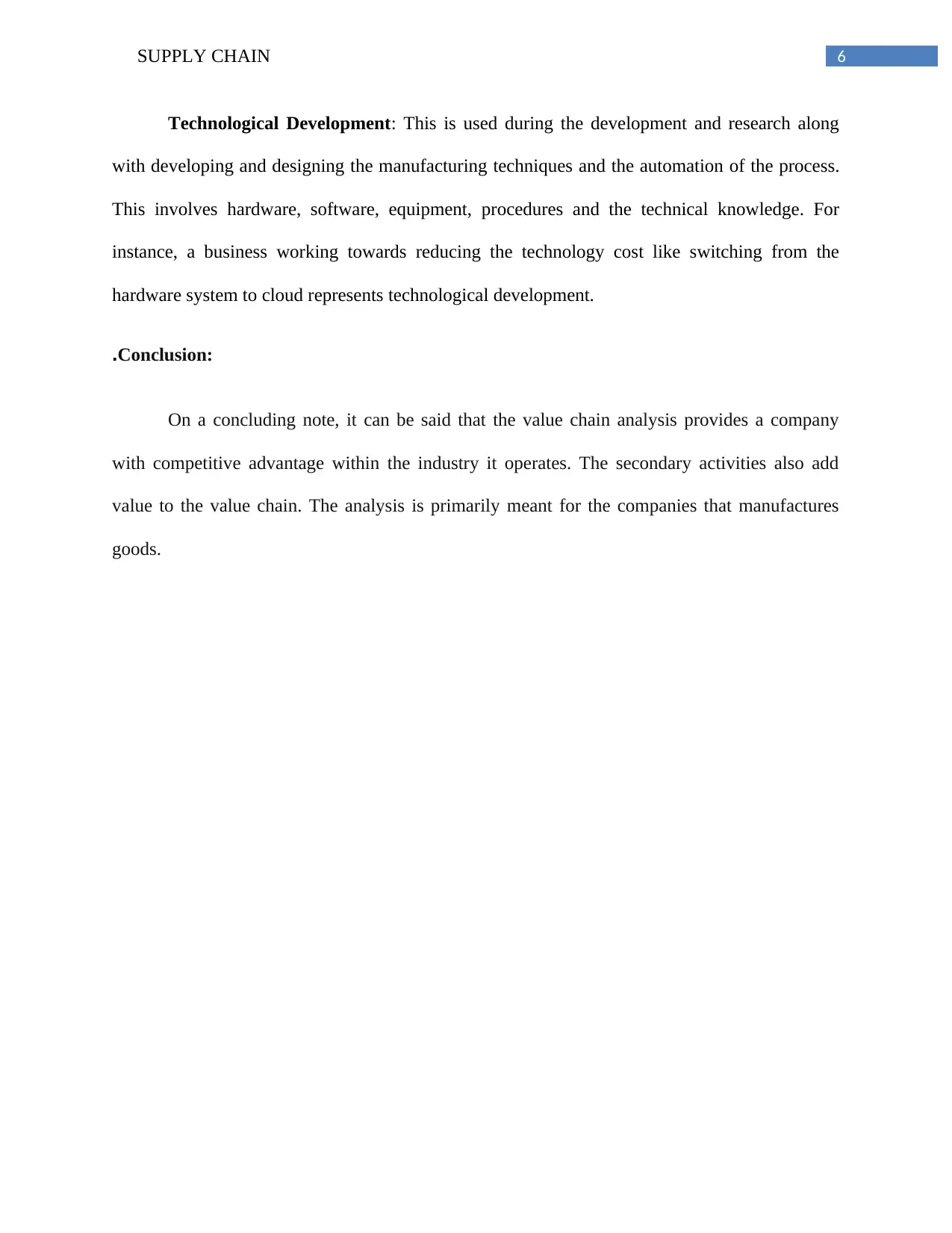
6SUPPLY CHAIN
Technological Development: This is used during the development and research along
with developing and designing the manufacturing techniques and the automation of the process.
This involves hardware, software, equipment, procedures and the technical knowledge. For
instance, a business working towards reducing the technology cost like switching from the
hardware system to cloud represents technological development.
.Conclusion:
On a concluding note, it can be said that the value chain analysis provides a company
with competitive advantage within the industry it operates. The secondary activities also add
value to the value chain. The analysis is primarily meant for the companies that manufactures
goods.
Technological Development: This is used during the development and research along
with developing and designing the manufacturing techniques and the automation of the process.
This involves hardware, software, equipment, procedures and the technical knowledge. For
instance, a business working towards reducing the technology cost like switching from the
hardware system to cloud represents technological development.
.Conclusion:
On a concluding note, it can be said that the value chain analysis provides a company
with competitive advantage within the industry it operates. The secondary activities also add
value to the value chain. The analysis is primarily meant for the companies that manufactures
goods.
Paraphrase This Document
Need a fresh take? Get an instant paraphrase of this document with our AI Paraphraser
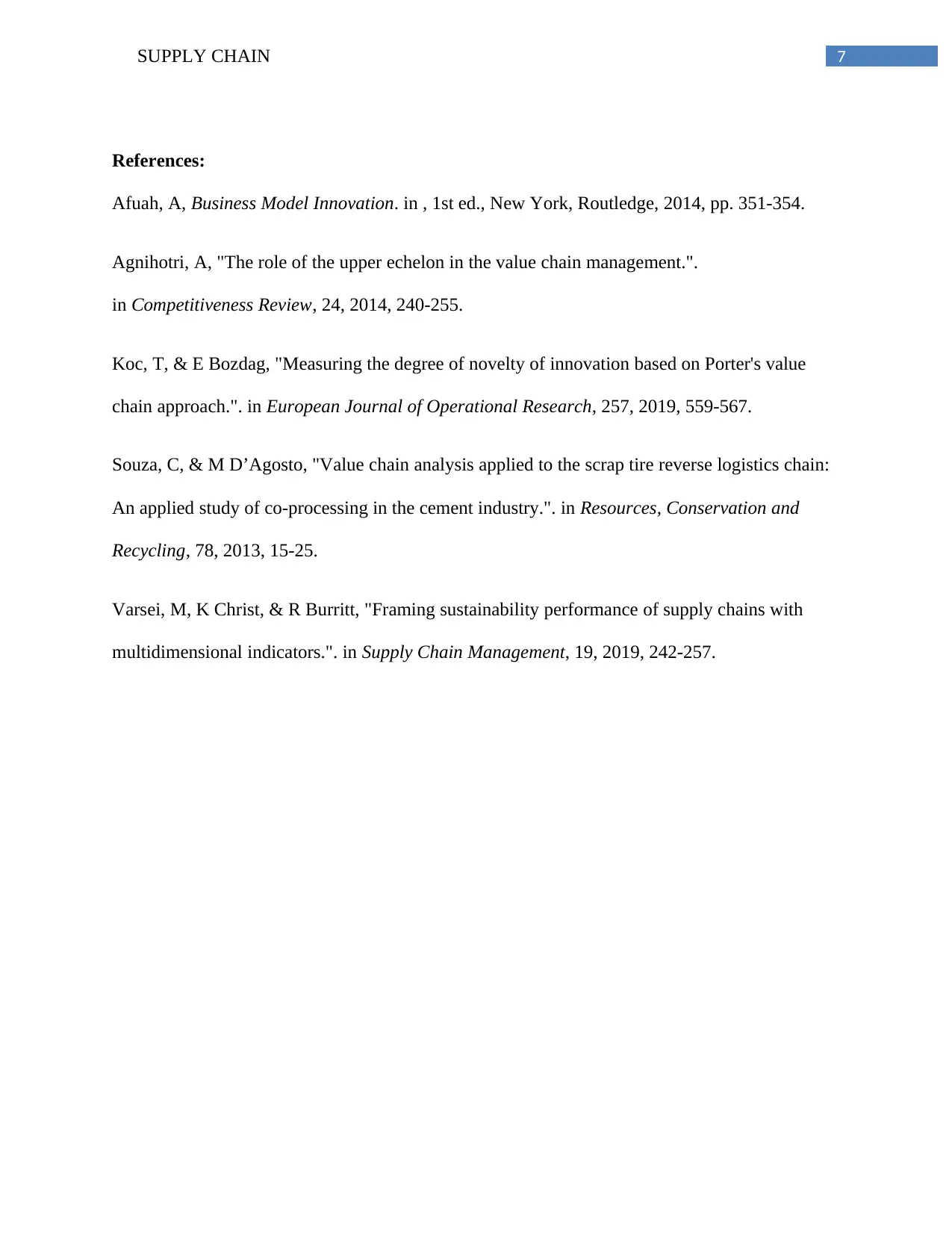
7SUPPLY CHAIN
References:
Afuah, A, Business Model Innovation. in , 1st ed., New York, Routledge, 2014, pp. 351-354.
Agnihotri, A, "The role of the upper echelon in the value chain management.".
in Competitiveness Review, 24, 2014, 240-255.
Koc, T, & E Bozdag, "Measuring the degree of novelty of innovation based on Porter's value
chain approach.". in European Journal of Operational Research, 257, 2019, 559-567.
Souza, C, & M D’Agosto, "Value chain analysis applied to the scrap tire reverse logistics chain:
An applied study of co-processing in the cement industry.". in Resources, Conservation and
Recycling, 78, 2013, 15-25.
Varsei, M, K Christ, & R Burritt, "Framing sustainability performance of supply chains with
multidimensional indicators.". in Supply Chain Management, 19, 2019, 242-257.
References:
Afuah, A, Business Model Innovation. in , 1st ed., New York, Routledge, 2014, pp. 351-354.
Agnihotri, A, "The role of the upper echelon in the value chain management.".
in Competitiveness Review, 24, 2014, 240-255.
Koc, T, & E Bozdag, "Measuring the degree of novelty of innovation based on Porter's value
chain approach.". in European Journal of Operational Research, 257, 2019, 559-567.
Souza, C, & M D’Agosto, "Value chain analysis applied to the scrap tire reverse logistics chain:
An applied study of co-processing in the cement industry.". in Resources, Conservation and
Recycling, 78, 2013, 15-25.
Varsei, M, K Christ, & R Burritt, "Framing sustainability performance of supply chains with
multidimensional indicators.". in Supply Chain Management, 19, 2019, 242-257.
1 out of 8
Related Documents
Your All-in-One AI-Powered Toolkit for Academic Success.
+13062052269
info@desklib.com
Available 24*7 on WhatsApp / Email
![[object Object]](/_next/static/media/star-bottom.7253800d.svg)
Unlock your academic potential
Copyright © 2020–2025 A2Z Services. All Rights Reserved. Developed and managed by ZUCOL.





